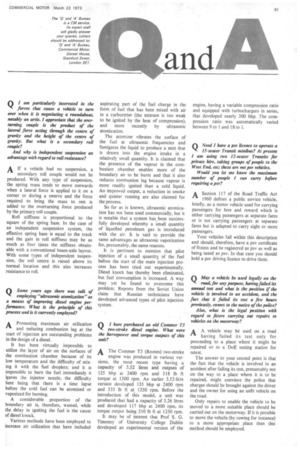Q Some years ago there was talk of employing "ultrasonic atomization"
Page 59

If you've noticed an error in this article please click here to report it so we can fix it.
as a means of improving diesel engine performance. What is the principle of this process and is it currently employed?
APromoting maximum air utilization and reducing combustion lag at the start of injection are outstanding problems in the design of a diesel.
It has been virtually impossible to utilize the layer of air on the surfaces of the combustion chamber because of its low temperature and the difficulty of mixing it with the fuel droplets; and it is impossible to burn the fuel immediately it leaves the injector nozzle, the difficulty here being that there is a time lapse before the cold fuel can be atomized or vaporized for burning.
A considerable proportion of the boundary air is, therefore, wasted, while the delay in igniting the fuel is the cause of diesel knock.
Various methods have been employed to increase air utilization that have included aspirating part of the fuel charge in the form of fuel that has been mixed with air in a carburetter (the mixture is too weak to be ignited by the heat of compression), and more recently by ultrasonic atomiz ation.
The atomizer vibrates the surface of the fuel at ultrasonic frequencies and fumigates the liquid to produce a mist that is drawn into the engine intake in a relatively small quantity. It is claimed that the presence of the vapour in the combustion chamber enables more of the boundary air to be burnt and that it also reduces combustion lag because vapour is more readily ignited than a cold liquid. An improved output, a reduction in smoke and quieter running are also claimed for the process.
So far as is known, ultrasonic atomization has not been used commercially, but it is notable that a system has been successfully developed whereby a small quantity of liquefied petroleum gas is introduced with the air. It is said to provide the same advantages as ultrasonic vaporization for, presumably, the same reasons.
It is pertinent to mention that pilot injection of a small quantity of the fuel before the start of the main injection process has been tried out experimentally. Diesel knock has thereby been eliminated, but fuel consumption is increased, A way may yet be found to overcome this problem. Reports from the Soviet Union claim that Russian technicians have developed advanced types of pilot injection system.












































































































